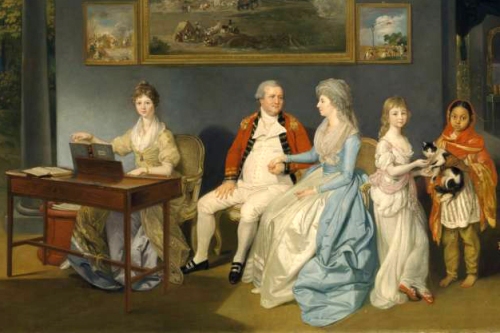After the East India Company attained a firm foothold in Calcutta in 1757, an influx of English middle-class civil and military personnel brought Western classical music to the subcontinent.
 A taste for arrangements of Indian melodies arose among these expatriates, prompting such publications as William Hamilton Bird’s The Oriental Miscellany: Being a collection of the most favourite airs of Hindoostan, compiled and adapted for the harpsichord (Calcutta: Cooper, 1789).
A taste for arrangements of Indian melodies arose among these expatriates, prompting such publications as William Hamilton Bird’s The Oriental Miscellany: Being a collection of the most favourite airs of Hindoostan, compiled and adapted for the harpsichord (Calcutta: Cooper, 1789).
In his introduction Bird complained that the songs’ brevity and “their want of variety” obliged him to compose variations for each one, and that their rhythms cost him “great pains to bring them into any form as to time.”
This according to “Corelli in Calcutta: Colonial music-making in India during the 17th and 18th centuries” by Raymond Head (Early music XIII/4 [November 1985] pp. 548–553).
Above, Johan Zoffany’s Colonel Blair with his family and an Indian ayah (Calcutta, 1786), showing a square piano or clavichord. Below, Daniel Laumans performs a “Hindustan air” arranged by Sophia Plowden around the same time.
Related article: How far can a song travel?




Great post, Dr. McAulay! We have returned the favor, linking to it above. Please be sure that RILM finds out when your publications are available; at the moment our coverage of the UK is a bit of a challenge due to budget cuts there. You can always check and improve our coverage here: http://submissions.rilm.org/login.asp?userTimedOut=0&accessdenied=%2Findex%2Easp
And from there, Hindustani melodies were copied into the private collection of some well-off Gaelic-speaking young sisters at the furthest end of the Hebridean island of Mull.
Dr. McAulay, have you blogged about this collection? If so, please send the link!
I haven’t blogged about it, though I did mention it in my thesis (which is currently at the publishers in its new book form); and I’ve a paper awaiting review. However, you’re right – I should blog it. I’ll put something together and certainly send you a link. Watch this space …
I have just posted a piece about the Maclean-Clephane’s song manuscript, on Whittaker Live, our performing arts blog:- http://whittakerlive.blogspot.co.uk/2012/05/how-far-can-song-travel.html – hope you find it interesting!